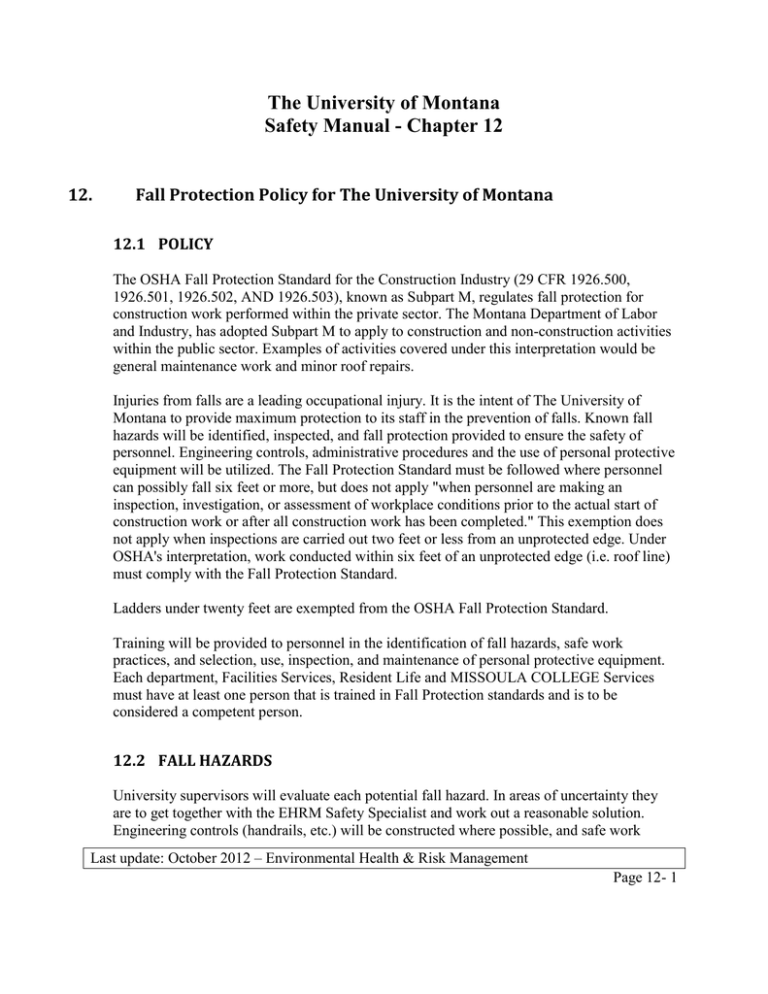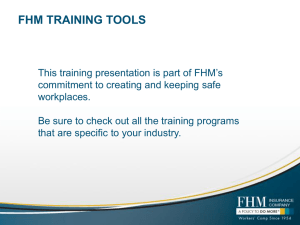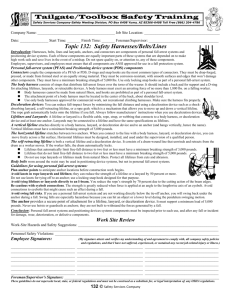The University of Montana Safety Manual - Chapter 12 12.
advertisement

The University of Montana Safety Manual - Chapter 12 12. Fall Protection Policy for The University of Montana 12.1 POLICY The OSHA Fall Protection Standard for the Construction Industry (29 CFR 1926.500, 1926.501, 1926.502, AND 1926.503), known as Subpart M, regulates fall protection for construction work performed within the private sector. The Montana Department of Labor and Industry, has adopted Subpart M to apply to construction and non-construction activities within the public sector. Examples of activities covered under this interpretation would be general maintenance work and minor roof repairs. Injuries from falls are a leading occupational injury. It is the intent of The University of Montana to provide maximum protection to its staff in the prevention of falls. Known fall hazards will be identified, inspected, and fall protection provided to ensure the safety of personnel. Engineering controls, administrative procedures and the use of personal protective equipment will be utilized. The Fall Protection Standard must be followed where personnel can possibly fall six feet or more, but does not apply "when personnel are making an inspection, investigation, or assessment of workplace conditions prior to the actual start of construction work or after all construction work has been completed." This exemption does not apply when inspections are carried out two feet or less from an unprotected edge. Under OSHA's interpretation, work conducted within six feet of an unprotected edge (i.e. roof line) must comply with the Fall Protection Standard. Ladders under twenty feet are exempted from the OSHA Fall Protection Standard. Training will be provided to personnel in the identification of fall hazards, safe work practices, and selection, use, inspection, and maintenance of personal protective equipment. Each department, Facilities Services, Resident Life and MISSOULA COLLEGE Services must have at least one person that is trained in Fall Protection standards and is to be considered a competent person. 12.2 FALL HAZARDS University supervisors will evaluate each potential fall hazard. In areas of uncertainty they are to get together with the EHRM Safety Specialist and work out a reasonable solution. Engineering controls (handrails, etc.) will be constructed where possible, and safe work Last update: October 2012 – Environmental Health & Risk Management Page 12- 1 The University of Montana Safety Manual - Chapter 12 practices and personal protective equipment will be used. Fall hazards include, but are not limited to, unprotected sides and edges of roofs, excavations, overhead construction and maintenance, roof work, floor holes, wall openings, and all other walking or working surfaces where personnel can possibly fall six feet or more to a lower level. At The University of Montana, fall hazards specifically include work on UM building roofs, maintenance work conducted where a fall of six feet or more from the floor is possible (this does not apply to work on scaffolds or ladders), including work on, lighting, or rafters. Protection from falling hazards must be provided. The placement of toe boards and the use of hard hats will be strictly enforced. Equipment shall not be stored within four feet of an unprotected edge. 12.3 ENGINEERING CONTROLS The first step in minimizing work hazards is to determine if engineering controls can eliminate or lessen the hazard of the job. Engineering controls of fall hazards consist of guardrails, toe boards, covers, and other rails or barriers that prevent falls. The University of Montana will provide engineering controls where possible to minimize fall hazards. Personnel should alert UM supervisors to potential fall hazards not already identified and controlled. Additionally anchor points (if necessary) will be installed at locations where personal fall arrest systems (PFAS) will be used. 12.4 ADMINISTRATIVE PROCEDURES (Work Practices) In all cases, safe work practices must be followed where potential for a fall exists. Evaluate the work and potential hazards. Prepare for hazards. Contact the supervisor or Environmental Health for implementation of engineering controls. Personnel must work in pairs at all times while conducting work where a potential for a fall exists. All work conducted within six feet of an unprotected edge where a fall exists must wear fall protection equipment. Only properly maintained and inspected equipment shall be used for fall protection. Equipment must be in compliance with the OSHA Fall Protection Standard. The Facilities Services Carpenter shop seals flat roofs on a regular basis each year and needs to submit a work plan to EHRM to insure that if it isn’t possible for two personnel to be working on a flat roof repair that the actual work taking place is made aware to the work order desk in case of an emergency. Workers shall inspect all equipment before use; if any equipment exhibits signs of wear, it must immediately be removed from service. Equipment must be maintained, and stored where it will it will not be subject to wear. In case of emergency, follow UM Emergency Last update: October 2012 – Environmental Health & Risk Management Page 12- 2 The University of Montana Safety Manual - Chapter 12 Procedures, which should include but be not limited to: calling either work order desk or office of public safety, or using the UM radio system. Body harnesses must be worn, lanyard attached to harness securely with locking snap hook, lifeline (if used) attached securely to lanyard, deceleration device attached correctly and securely to lifeline and lanyard, and lifeline or lanyard must be securely connected, by locking snap hook, to the anchor point before any work shall be conducted. Inspections are exempted from this requirement per OSHA guidelines. However OSHA does require fall protection when inspections occur two feet or less from an unprotected edge or side. Inclement weather, including but not limited to snow, ice, high winds or rain, pose even greater hazards during work where a potential for a fall exists, i.e. roof work. Personnel shall take additional precautions during such weather. Personnel should contact their supervisor to review additional precautions before beginning affected work. Work should not be conducted on roofs during lightning storms. 12.5 PERSONAL PROTECTIVE EQUIPMENT The use of personal protective equipment to minimize fall hazards shall be strictly enforced. The optimal solution is to use engineering controls, but if engineering controls do not eliminate the hazard, work practices and personal protective equipment must be used. The use of personal fall arrest systems (PFAS) are the allowed personal protective equipment for fall hazards at the UM. A PFAS consists of a full-body harness, lanyard, and anchor point. A second option is to use a full-body harness, lanyard, lifeline, anchor point, and deceleration (grabbing) device. Only full-body harnesses shall be used, the use of a body belt is prohibited. Non-locking snap hooks are unacceptable for personal fall arrest systems. Requirements (from OSHA 1926.502) of a personal fall arrest system (PFAS) include: D-rings and snap hooks shall have a minimum tensile strength of 5000 pounds. A proof test of 3600 pounds is required. Lanyards and lifelines shall have a minimum breaking strength of 5000 pounds. Lanyards shall not exceed six feet in length. Self-retracting lifelines and lanyards shall have strength of at least 3000 pounds and limit free fall to two feet or less. Anchor points for fall arrest systems shall be capable of supporting at least 5000 pounds per employee when the system is designed, installed (temporarily or permanently), and used under the supervision of a qualified person. Last update: October 2012 – Environmental Health & Risk Management Page 12- 3 The University of Montana Safety Manual - Chapter 12 Personal fall arrest systems shall limit the maximum arresting forces to 1800 pounds with a full body harness. The maximum free fall distance is six feet for systems. The maximum deceleration distance is 3.5 feet. Personal fall arrest systems shall have sufficient strength to withstand twice the potential impact energy of the falling employee. Impacted components shall be removed from service. Prompt rescue shall be provided for personnel who have fallen. Personal fall arrest systems shall be inspected prior to each use. Lifelines subject to cutting or abrasion shall be a minimum of 7/8-inch wire core manila rope. All other lifeline applications shall use a minimum of 3/4 inch manila rope or its equivalent. Any other personal protective equipment deemed necessary for the task under the Personal Protective Equipment Standard must be worn. This includes but is not limited to hardhats, gloves, safety glasses, and covered-toed boots. Hard hats must be worn within an area beneath elevated work where objects could fall from a height and strike a worker. 12.6 EQUIPMENT INSPECTIONS Equipment inspections will be conducted by personnel prior to use. If, upon inspection, a piece of equipment shows any of the following signs of wear it must immediately be removed from service. Cuts or frayed edges, Abrasions, Mildew or mold, Undue stretching, Chemical burns, Dryness, Corrosion or charring, Broken stitches, Inner fiber fuzziness, Rivets that are loose or distorted, Substances that have penetrated and hardened in the fibers, Deformed thimbles or enlarged buckle tongue holes or grommets, Damaged or distorted snap hooks or faulty springs, Cracks or distortions in fall protection hardware. Consult Environmental Health & Risk Management regarding inspection of equipment, or if equipment condition is in question. It is the responsibility of the end-user to determine when a harness or lanyard is unfit for use and should be removed from service. 12.7 TRAINING Training in fall protection must be obtained prior to working where potential for a fall exists. This training will be conducted annually by an authorized training resource. Training will consist of learning to identify fall hazards, minimize fall hazards, and the function, use, inspection, and maintenance of personal fall arrest systems (PFAS) and Last update: October 2012 – Environmental Health & Risk Management Page 12- 4 The University of Montana Safety Manual - Chapter 12 other restraint equipment. Trainees will also be taught how to identify and inspect anchor points, substantial members of the building structure, or securely rigged lines, which will safely suspend the worker in case of fall. Only attendees of the fall hazard training classes will be allowed to conduct work where potential for a fall exists. Each Department will maintain records of attendance. 12.8 DEFINITIONS Anchor point-A secure point of attachment for lifelines, lanyards or deceleration(grabbing) devices. Body belt-A strap with means both for securing it about the waist and for attaching it to a lanyard, lifeline, or deceleration(grabbing) device. Body belts are prohibited at The University of Montana. Body harness-An interconnected set of straps that may be secured about a person in a manner that distributes the fall arrest forces over at least the thighs, pelvis, waist, chest, and shoulders with a means for attaching the harness to other components of a personal fall arrest system. Connector-A device that is used to connect parts of a personal fall arrest system together(i.e. D-rings, and snap hooks). Deceleration device-Any mechanism, such as a rope, grabbing device, ripstitch lanyard, specially woven lanyard or automatic self-retracting lifeline/lanyard, which serves to dissipate a substantial amount of energy during a fall arrest, or otherwise limits the energy imposed on an employee during fall arrest. Deceleration distance-The additional vertical distance a falling person travels, excluding lifeline elongation and free fall distance, before stopping, from the point at which a deceleration device begins to operate. Guard rail-A barrier erected to prevent personnel from falling to lower levels. Hole-A void or gap in a floor, roof, or other walking/working surface. Lanyard-A flexible line of rope or strap that generally has a connector at each end for connecting the body harness to a deceleration device, lifeline or anchor point. Last update: October 2012 – Environmental Health & Risk Management Page 12- 5 The University of Montana Safety Manual - Chapter 12 Lifeline-A component consisting of a flexible line for connection to an anchor point at one end to hang vertically and that serves as a means for connecting other components of a personal fall arrest system to the anchor point. Opening-A gap or void in a wall or partition through which personnel can fall to a lower level. Personal fall arrest system(PFAS)-A system including but not limited to an anchor point, connectors, and a body harness used to arrest a worker in a fall from a working level. Rope grab(grabbing device)-A deceleration device that travels on a lifeline and automatically, by friction, engages the lifeline and locks to arrest a fall. Self-retracting lifeline/lanyard-A deceleration device containing a drum-wound line which can be slowly extracted from, or retracted onto, the drum under minimal tension during normal movement and which, after onset of a fall, automatically locks the drum and arrests the fall(usually within two feet or less). Snap hook-A connector consisting of a hook-shaped member with a normally closed keeper, or similar arrangement, which may be opened to permit the hook to receive an object and, when released automatically closes to retain the object. Only locking snap hooks are permitted at The University of Montana. Toe board-A low protective barrier that prevents material and equipment from falling to lower levels and which protects personnel from falling. Unprotected sides and edges-Any side or edge of a walking/working surface where there is no wall or guardrail system at least 1 meter high(i.e. roof lines). Walking/working surface-Any surface, whether horizontal or vertical, on which personnel walk or work, including but not limited to floors, roofs, or ramps. It does not include ladders or vehicles on which personnel must be located to perform their work duties. Last update: October 2012 – Environmental Health & Risk Management Page 12- 6




